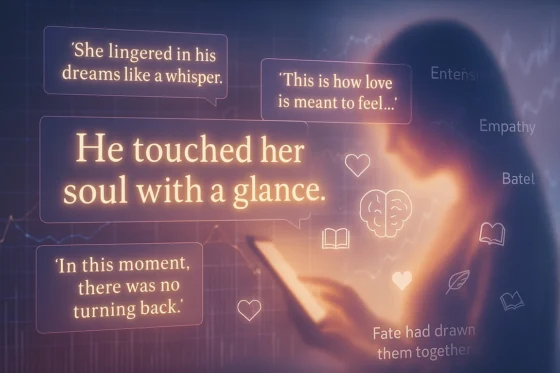Recall the excitement of thumbing through pages of a choose-your-own-adventure book, excited to make the next move of the protagonist? Now, imagine that experience amplified—where an AI interactive story-telling not only presents choices but crafts a narrative that adapts in real-time to your decisions, preferences, and emotions.
This evolution is at the heart of AI interactive story-telling, a burgeoning field that’s transforming passive reading into dynamic, personalized adventures. Thanks to the development in natural language processing and machine learning, AI-generated stories are becoming more interesting, authentic, and customizable.
In this article, we’ll delve into how AI interactive story-telling platforms operate, explore their appeal to modern audiences, and guide you on embarking on your own interactive storytelling journey.
What Are AI Interactive Story-Telling Platforms?
Interactive story platforms are digital playgrounds for your imagination—where you’re not just reading a story, you’re actively shaping it. Unlike the traditional books or even the majority of video games, these platforms allow you to make choices, which will directly affect the plot, dialogue, and endings. It is you who decide what the characters are saying, how they are acting and where the story will go from there. It’s where you drive the car in storytelling.
But here’s the modern twist: AI interactive story-telling takes this concept to a whole new level. Rather than limiting themselves to pre-written limited branches, AI driven platforms create story elements on the moment – reacting to your input in real time. You’re not making a choice from a menu; you’re co-creating a narrative with an AI interactive storyteller who listens, reacts, and builds the world alongside you.
Why does this matter? For it turns the traditional reading experience upside down. You’re not longer a passive spectator of another man’s plot you’re a collaborator a character and a co-author. Whether it’s solving a mystery, or going on a romance, or building an epic fantasy world, your choices are the pulse of the story.
Interactive storytelling platforms powered by AI invite you into an immersive, personalized experience where no two adventures are ever the same—and that’s what makes them so compelling.
Love immersive experiences?
Join a growing TalkToStory Community and bring your characters, worlds, and stories to life alongside like-minded creators.
The Evolution of AI Interactive Story-telling
AI interactive story-telling has evolved significantly over the years, from simple text-based games to complex, AI-powered narratives that react to your choices. The early platforms were rather straightforward, providing a handful of paths and outcomes, but as AI became popular, the platforms have been growing more complex, providing real-time experiences that are tailored specifically to each user and are highly immersive.
The Early Days – Choose-Your-Own-Adventure and Text-Based Games
The concept of interactive storytelling began with the classic choose-your-own-adventure books of the 1970s and 1980s. Such books enabled readers to make choices that influenced the final outcome of the story. However, the structure was rather simple – select one option from a few choices and flip to the corresponding page. Such books gave a sense of agency but were poor in terms of depth and personalization that modern technology is capable of.
In the 1980s, the evolution of interactive storytelling took a digital turn with text-based adventure games. Such titles as Zork (1980) and The Hitchhiker’s Guide to the Galaxy (1984) became landmark titles. These were primitive games that allowed players to playfully manipulate a story by entering commands that would determine the direction in which the story responded to the player. However, although these games were interactive, the stories were still constrained by the preprogrammed scenarios, and the player’s moves were frequently restricted by the fixed logic of the system.
The Rise of Visual Novel Platforms
As technology advanced, so did the complexity of interactive storytelling. One of the other big steps that came in this evolution was the emergence of visual novel platforms in late 90s and early 00s, particularly in Japan. Games like Clannad (2004) and Danganronpa (2010) took interactive storytelling to new heights by incorporating full narratives, branching paths, and character relationships that were influenced by player choices. These games mixed up static art, text-based dialogue and a variety of possible endings, more empowering the players in changing the ending. Though these games still featured set endings, there were greater opportunities for thematic immersion and more complex narrative entangling.
However, like earlier forms of interactive storytelling, these games had limitations. The amount of story branches was still limited, and although the characters and dialogue could vary depending on the player’s input, the choices were still encoded, and more extensive.
The Advent of AI-Powered Platforms – Personalization Takes Center Stage
With the advancement of AI interactive story-telling, the game has changed once again. Thanks to AI technologies, specifically in the field of natural language processing and machine learning, platforms can write not just branches on a tree, but lively, breathing stories that dynamically adjust to each user’s interaction in real time.
Real-Time Decision Trees and Personalized Storylines
With AI’s capacity to process vast amounts of data and understand the nuances of language, newer platforms are incorporating real-time decision trees that adapt to user input as the story progresses. For instance, Replika, an AI chatbot that allows users to engage in conversations with an AI companion, offers a form of storytelling where the narrative adjusts based on the user’s emotions, interests, and past interactions. This makes each conversation feel unique, as the AI learns and responds to the user’s preferences over time.
In the realm of gaming, The Turing Test (2016) by Bulkhead Interactive introduces a story with puzzles and challenges that players must solve through their interactions with the environment, but the AI reacts to the way the player solves these problems, creating a personalized experience based on the choices made throughout the game.
Love immersive experiences?
Join a growing TalkToStory Community and bring your characters, worlds, and stories to life alongside like-minded creators.
Behind the Magic – How AI Understands Your Story Choices
Have you ever played an AI-powered story and wondered “how did it know what I meant?”. Whether you’re sneaking past goblins, starting a romance with a rogue prince, or solving a murder mystery in space, AI interactive storytellers feel incredibly intuitive. But what is actually happening behind the scenes? Here is how these smart bots transform your decisions into live, changing adventures, without coding, writing, or planning anything beforehand.
The AI Reads and Understands Your Input
When you type in or talk into an AI story platform, it does not simply search for keywords such as “run” or “fight”. It analyses your whole sentence to know what you are doing, how the character in the sentence feels and what you can have in terms of an outcome.
Example
You say: I glare at the thief and ask him to return my necklace. The AI knows that you’re angry, it pinpoints the thief as the target, and realizes that you’re starting a fight. It frames things-tense, perhaps a little dramatic-and prepares the next scene to fit.
This ability originates from the manner with which the AI has been trained: it’s read billions of words from books to roleplays, fanfiction, and even online chats. Therefore, when you enter anything, it draws on its huge “story brain” to give a response that makes sense.
It Predicts What Happens Next
AI story platforms are not pre-defined; instead, they are like those of choose your own adventure books, but not the pre-set one. That means that they write the next part of the story on the go – based on your most recent input and everything that’s happened thus far. The essence of this is a language model (GPT for example), which is fundamentally a really intelligent text predictor. It analyzes your prompt and it considers: “What would be the most interesting, or logical thing to do next?”
That might mean:
- Writing vivid dialogue from side characters
- Reacting to your tone (aggressive, flirty, cautious)
- Introducing a twist (you realize the thief is your brother!)
- Or following through on your decision (a fight breaks out)
Because it doesn’t rely on pre-written paths, the possibilities are almost infinite.
It Tracks the Story (So It Doesn’t Forget Who You Are)
To keep things immersive, AI story needs memory—or at least a working short-term version of it. These systems are designed to remember key facts from earlier in the story so things stay consistent. For example:
- Your character’s name, personality, or backstory
- Events that have happened (you fell into a trap, befriended a dragon)
- Relationships you’ve built with other characters
- Items you picked up, quests you’ve completed, or lies you’ve told
If you confessed a secret in Chapter 2, the AI might bring it back in Chapter 6 to create emotional depth or drama. That’s how it builds continuity and makes your story feel cohesive—like it was all planned from the start (even though it wasn’t!).
It Responds in Real Time
This is where the magic indeed reflects itself. You type a line … and in the next moment the AI carries on the story. No waiting, no browsing through options – it just goes. That immediate feedback makes it a smooth, immersive experience. This on-the-go response is supported by cloud computing and quick algorithms. It’s like having a private story teller across from you—improvising off everything you spew at him – and never tiring.
So, Is It All Just Code? Or Something More?
Of course, it’s powered by algorithms and machine learning, but it feels a lot like imagination alchemy. The AI isn’t only authoring text. It’s creating a world around you. And since it conforms to your choice, everyone’s path is unique. It’s not about stealing authors – it’s about being co-creators of something magical.
Your Story, Your Rules
Whether you’re diving into a romantic drama, a spooky mystery, or a sci-fi rebellion, AI interactive story telling puts you at the center of the action. It knows what you want, responds instantly, and delineates a world to suit your imagination.
So the next time you are thrown into a twisty dungeon or a royal court full of secrets by your AI storybot, recall that: it’s not just storytelling, it’s storytelling about your own story.
Love immersive experiences?
Join a growing TalkToStory Community and bring your characters, worlds, and stories to life alongside like-minded creators.
Why People Are Hooked
AI interactive story-telling is more than just a novelty—it’s addictive. Whether you’re a serious reader or a roleplayer or a writer looking for inspiration, there’s something irresistible about a world in which you exist and with which you interact. This is why people keep coming for more.
Readers Love…
Becoming the Hero—or the Villain
You no longer have to sit and watch another person’s story develop. In these platforms, you are the protagonist. Get your revenge, fall in love with a vampire, or spoil a kingdom with fear? It’s up to you, and the AI accommodates.
Infinite Replayability
No two adventures are the same. You can start with the same premise and end up in entirely different places depending on your decisions. One story might end in romance, another in betrayal, another in intergalactic war. This endless variety makes the experience feel fresh every time.
Control Over the Narrative
There’s something special about being able to write your own story. Every decision—big or small—matters. AI interactive story-telling gives you that “what if?” power, turning passive reading into active, personalized play.
Writers Love…
Co-Creating With AI
Writers are using AI interactive story-telling as a creative partner—brainstorming dialogue, generating plot twists, or writing side characters. It’s like having an endless collaborator who will keep generating ideas when your well has dried up.
Letting Fans Experience Their Worlds
For authors, game creators, and fanfiction writers, AI interactive story-telling offers a way to bring their stories to life in an interactive format. Fans can play, perhaps, have different paths, have relationships with characters, dig deeper into lore, however they want.
Love immersive experiences?
Join a growing TalkToStory Community and bring your characters, worlds, and stories to life alongside like-minded creators.
Related Articles





